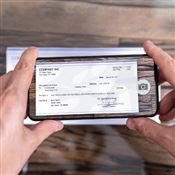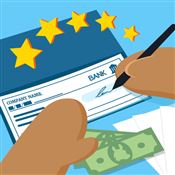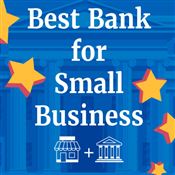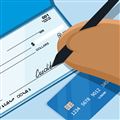Is It Bad to Have Multiple Checking Accounts?
Ad Disclosure: This article contains references to products from our partners. We may receive compensation if you apply or shop through links in our content. This compensation may impact how and where products appear on this site. You help support CreditDonkey by using our links.
Thinking of getting another checking account? First, find out the effects of multiple banks on your credit score and finances.
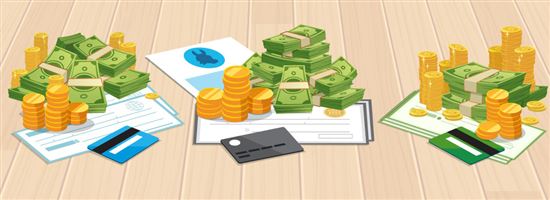 |
There are plenty of reasons why it makes sense to have multiple checking accounts.
Maybe you want to take advantage of new account bonuses. Or you want the high APY of an online bank and the convenience of a brick-and-mortar bank.
Here's the good news: It's totally okay to open multiple checking accounts as long as you keep the accounts in good standing. Learn how to safely keep multiple checking accounts in the guide below.
U.S. Bank Smartly® Checking - Up to $450 Bonus
Earn up to $450 with a new Bank Smartly Checking account. Complete the following within 90 days of account opening:
- Enroll in online banking or the U.S. Bank Mobile App
- Make two or more direct deposit(s) totaling $2,000 to $4,999.99 to earn $250, $5,000 to $7,999.99 to earn $350 or $8,000 or more to earn $450
Fund your new account within 30 days to start qualifying activities. Offer may not be available if you live outside of the U.S. Bank footprint or are not an existing client of U.S. Bank or State Farm.
Does having multiple checking accounts hurt your credit?
The number of checking accounts you have, and the balance of those accounts, does not affect your credit score. Your credit score is more influenced by credit accounts and debt.
It's fine to have more than a couple bank accounts as long as they are in good standing. This means you have a positive balance and avoid excessive overdrafts.
On average, Americans own 5 accounts across all types of financial institutions. Most consumers spread them across three different banks.[1]
How many checking accounts should you have?
There's no limit on the number of checking accounts you can open. The number of checking accounts you should have will depend on your personal finance goals.
Here are a few reasons why you might need multiple checking accounts:
- Almost everyone needs a basic checking account
- Business owners can separate finances with a business checking account
- Consider opening a joint checking account with a spouse or partner
- Opt for a high-yield checking if you want high APY and accessibility
Just remember, multiple checking accounts means more maintenance fees. Usually, you need to maintain a certain balance to waive monthly service fees. Stay on top of your finance to avoid unnecessary fees.
Note: The Federal Deposit Insurance Corporation (FDIC) limits how much money is insured in your checking account. The standard FDIC coverage amount is $250,000 per depositor across all accounts with the same bank.
Chase Total Checking® - $300 Bonus
- New Chase checking customers enjoy a $300 bonus when you open a Chase Total Checking® account with qualifying activities
- With over 4,700 branches, Chase has the largest branch network in the U.S. plus access to more than 15,000 ATMs.
- Chase Mobile® app - Manage your accounts, deposit checks, transfer money and more -- all from your device.
- JPMorgan Chase Bank, N.A. Member FDIC
- Open your account online now
- Available online nationwide except in Alaska, Hawaii and Puerto Rico. For branch locations, visit locator.chase.com.
- Chase Overdraft Assist℠ - no overdraft fees if you're overdrawn by $50 or less at the end of the business day or if you're overdrawn by more than $50 and bring your account balance to overdrawn by $50 or less at the end of the next business day*
Is it ok to bank with more than one bank?
It's fine to have a checking account at more than one bank. You might want to do this for reasons like:
- Other banks might offer interest-bearing checking
- Other banks may have more convenient branch access
- You may have a separate joint account with a spouse at a different bank than your personal account
You can have more than one checking account with the same bank. Some banks even give you relationship benefits in the form of a higher savings interest rate or waive the monthly fee.
Is it bad to have bank accounts at different banks?
It's completely okay to have checking accounts at different banks. Just make sure you can successfully manage each account. You don't want to accidentally use the wrong account or bounce checks. Banks can close your account for these mishaps.
If you have more bank accounts than you can carefully manage, then you have too many accounts and that's a bad thing.
Pros and Cons of multiple checking accounts
Here are the advantages and downsides of more than one checking account to consider:
Pros
- Can be easier to manage finances
- Take advantage of new checking account bonuses
- Married folks and partners can easily separate finances
- Cover more of your money under FDIC (if accounts are with different banks)
- Separate accounts prevent business and personal expenses from being mixed up (and decrease risk of fraud)
Cons
- Requires good organization
- Monthly service fees can add up
- Greater risk of overdraft and insufficient funds fees
- Harder to keep track of deposits and withdrawals
- Harder to meet minimum balance requirements for multiple accounts
5 types of checking accounts
There are multiple kinds of checking accounts, each with its own perks and features. Consider your financial needs and goals to choose the right fit for you.
Basic Checking Account
A basic checking account is best for performing everyday transactions, like withdrawing money, paying bills, and making purchases. It usually does not pay interest; it also comes with checks and a debit card.
High-Yield Checking Account
These interest-bearing accounts allow you to earn interest on your checking balance. Some banks also call this type of account by a different name, like "Rewards Checking" or "Premium Checking."
Business Checking Account
If you own a small business, it's best to keep your business expenses separate from your personal ones. There are lots of business checking account options for all business sizes - from small freelancers to enterprises.
Student/Teen/Kids Checking Account
Student checking accounts are for college students, usually age 17-24. You must be enrolled in a school to open an account.
Teen and kids accounts are usually for kids younger than 18; they require parent access and approval to open.
Senior Checking Account
These special checking accounts are designed to offer more stress-free banking for seniors. They may include advantages like lower fees and free checks.
Compare Checking Accounts
U.S. Bank Smartly® Checking - Up to $450 Bonus
Earn up to $450 with a new Bank Smartly Checking account. Complete the following within 90 days of account opening:
- Enroll in online banking or the U.S. Bank Mobile App
- Make two or more direct deposit(s) totaling $2,000 to $4,999.99 to earn $250, $5,000 to $7,999.99 to earn $350 or $8,000 or more to earn $450
Fund your new account within 30 days to start qualifying activities. Offer may not be available if you live outside of the U.S. Bank footprint or are not an existing client of U.S. Bank or State Farm.
Chase Total Checking® - $300 Bonus
- New Chase checking customers enjoy a $300 bonus when you open a Chase Total Checking® account with qualifying activities
- With over 4,700 branches, Chase has the largest branch network in the U.S. plus access to more than 15,000 ATMs.
- Chase Mobile® app - Manage your accounts, deposit checks, transfer money and more -- all from your device.
- JPMorgan Chase Bank, N.A. Member FDIC
- Open your account online now
- Available online nationwide except in Alaska, Hawaii and Puerto Rico. For branch locations, visit locator.chase.com.
- Chase Overdraft Assist℠ - no overdraft fees if you're overdrawn by $50 or less at the end of the business day or if you're overdrawn by more than $50 and bring your account balance to overdrawn by $50 or less at the end of the next business day*
Bank of America Advantage Banking - $200 Bonus Offer
- The $200 bonus offer is an online only offer and must be opened through the Bank of America promotional page.
- The offer is for new checking customers only.
- Offer expires 9/30/2024.
- To qualify, open a new eligible Bank of America Advantage Banking account through the promotional page and set up and receive qualifying direct deposits totaling $2,000 or more into that new eligible account within 90 days of account opening. Bank of America Advantage SafeBalance Banking® for Family Banking accounts are not eligible for this offer.
- Once all requirements are met, Bank of America will attempt to pay bonus within 60 days.
- Additional terms and conditions apply. See offer page for more details.
- Bank of America, N.A. Member FDIC.
HSBC Premier - Earn Up to $2,500
You could earn $1,500 or $2,500 if you open a new, eligible HSBC Premier checking account from July 1, 2024 through November 22, 2024, and complete qualifying activities.
- Get a $1,500 Cash Bonus: Add New Money of $100,000 to $249,999 in deposit and/or eligible investment accounts within 20 days of opening your new checking account and maintain the Qualifying Balance for 3 full consecutive months.
- Get a $2,500 Cash Bonus: Add New Money of $250,000+ in deposit and/or eligible investment accounts within 20 days of opening your new checking account and maintain the Qualifying Balance for 3 full consecutive months.
- Cash Bonus will be deposited into your new checking account within 8 weeks of meeting all the offer requirements.
Chase Secure Banking℠ - $100 Bonus
- New Chase checking customers enjoy a $100 checking account bonus when you open a Chase Secure Banking℠ account with qualifying transactions. Open online or at any Chase branch.
- Set up direct deposit and you may get your money up to two business days early-exclusively for Chase Secure Banking℠ customers.
- No minimum deposit to open an account and get started plus no overdraft fees with a Chase debit card that helps you stay within your balance.
- No need to worry about overdraft fees - Chase Secure Banking℠ allows you to spend only the money you have available.
- Chase Secure Banking℠ customers told us they save an average of more than $40 per month on fees after opening their account.
- Pay bills, cash checks and send or receive money with Zelle® with a Chase Secure Banking℠ account.
- Bank from anywhere with access to more than 15,000 Chase ATMs, more than 4,700 Chase branches, the Chase Mobile® app and Chase.com.
- JPMorgan Chase Bank, N.A. Member FDIC.
Bottom Line
There's no set number for how many checking accounts you should have. How many accounts you should have depends on your personal circumstances and financial situation.
If you're in the market for a checking account, be sure to check out these free checking options and bank bonuses without direct deposit requirements.
References
- ^ "ATM Banking: It's Not Just About Cash Withdrawal Anymore": Mercator Advisory Group, 2019.
Amber Kong is a content specialist at CreditDonkey, a bank comparison and reviews website. Write to Amber Kong at amber.kong@creditdonkey.com. Follow us on Twitter and Facebook for our latest posts.
Note: This website is made possible through financial relationships with some of the products and services mentioned on this site. We may receive compensation if you shop through links in our content. You do not have to use our links, but you help support CreditDonkey if you do.
|
|
| ||||||
|
|
|




